INSIDE and OUT: Closing the Cancer Gap in LGBTQIA+ Communities
- Global Health
- Social Justice
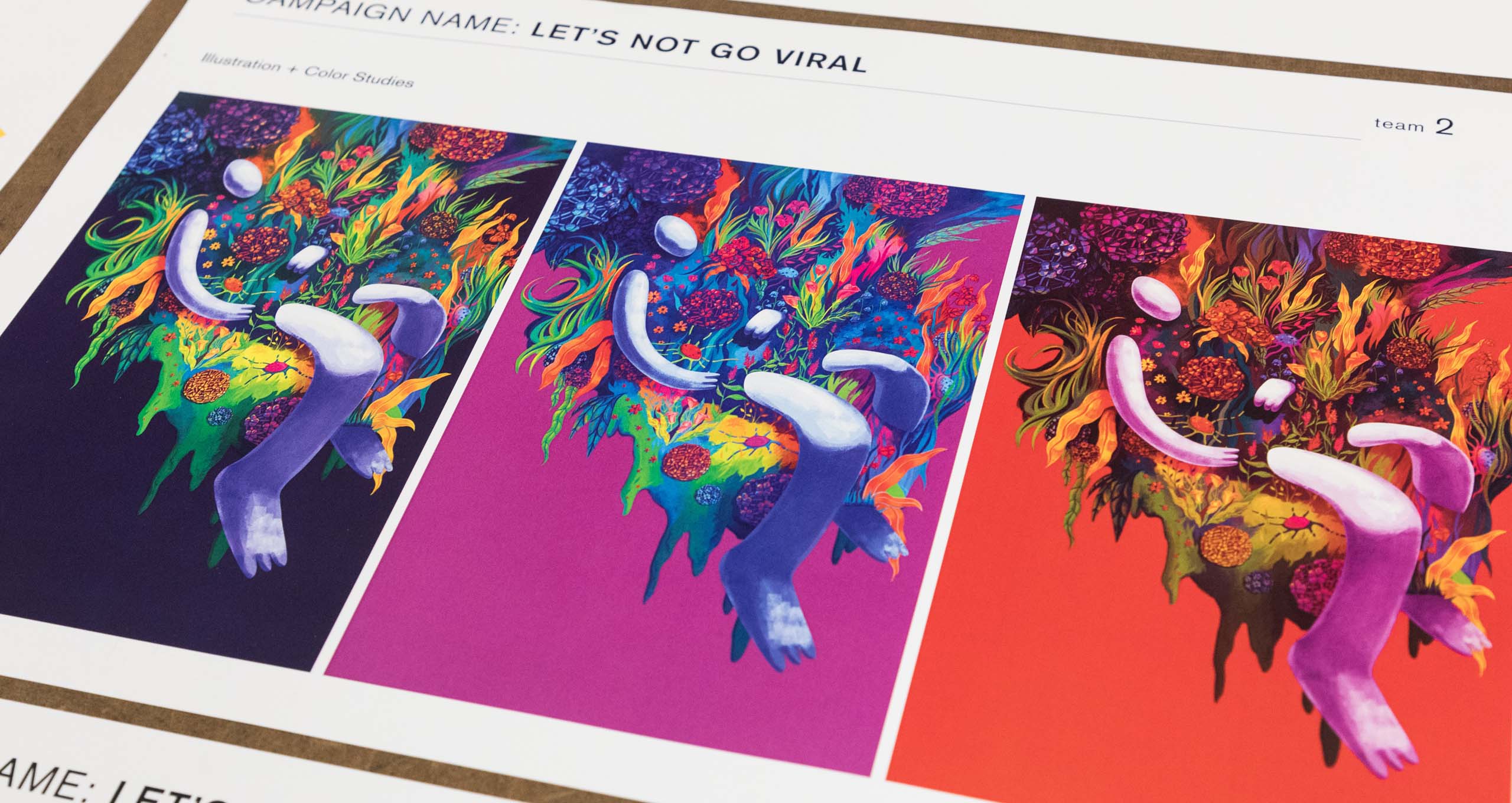
In partnership with Cedars-Sinai Research Center for Health Equity (RCHE), this Designmatters Transdisciplinary Studio (TDS), co-hosted by the Graphic Design department, challenged ArtCenter students to create a comprehensive transmedia campaign targeted to youth in LGBTQIA+ communities which would raise awareness/knowledge and present calls-to-action to prevent cancers associated with Human Papillomavirus (HPV).
ArtCenter students engaged with researchers, doctors, healthcare providers, community organizations, and advocates to understand the history and severity of the cancers as it impacts the LGBTQIA+ communities in order to develop effective campaign elements across multiple platforms.
Project Brief
In this studio, ArtCenter students were challenged to create a comprehensive awareness campaign about the threat of cancers associated with Human Papillomavirus (HPV). The goal was to target youth in LGBTQIA+ communities and present specific calls-to-action to get the HPV vaccination.
Through research and engagement with doctors, healthcare providers, community organizations, ethnic and immigrant groups and advocates, ArtCenter students learned about cancers related to HPV and the health research indicating those cancers have an outsized impact on LGBTQIA+ communities. Students also learned about the history of activism in the LGBTQIA+ communities, which guided them in developing a strategic awareness campaigns across multiple platforms to effectively reach targeted communities.
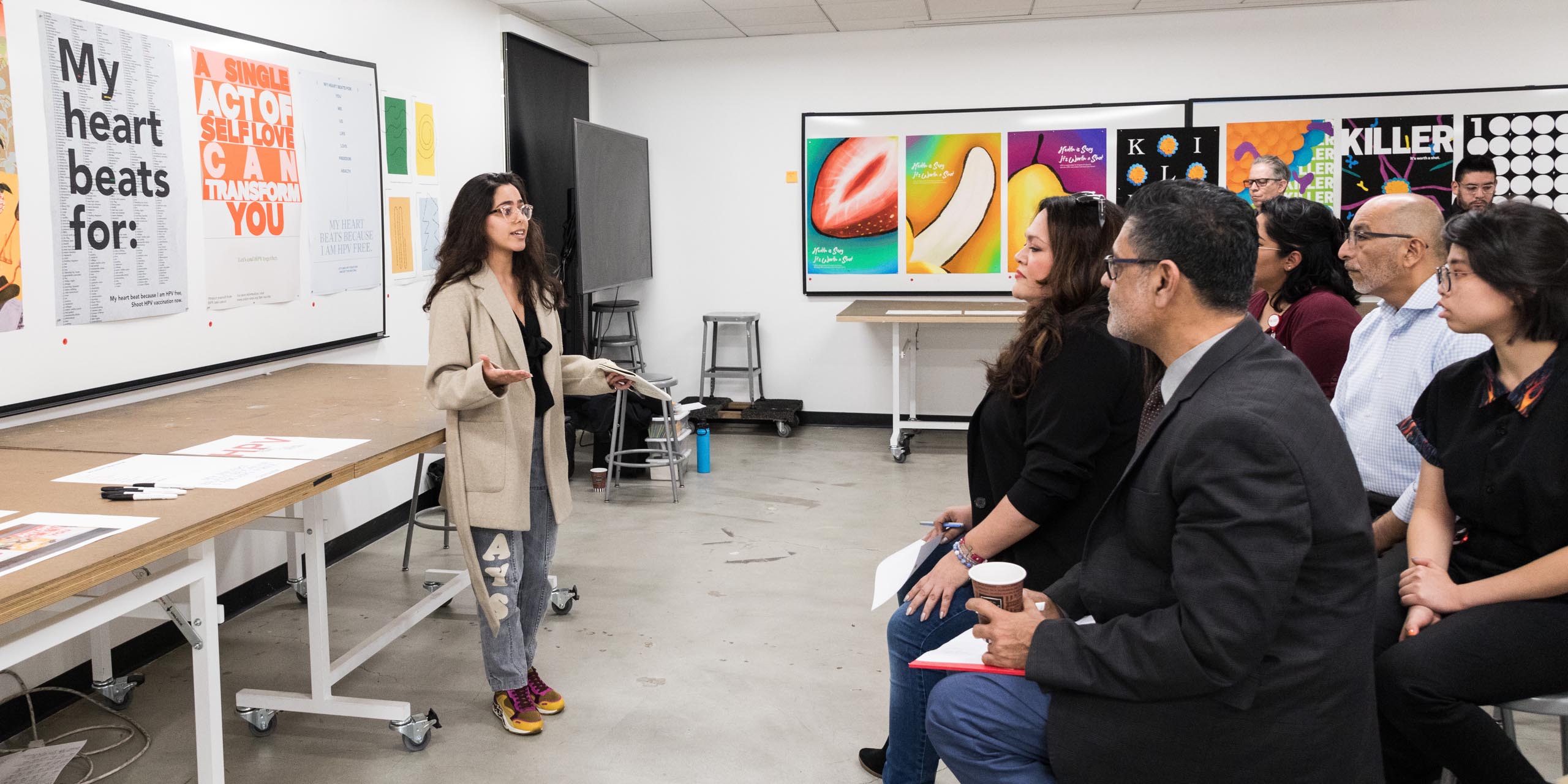
“I work for a nonprofit that directly works with these types of campaigns by pushing out different health disparities and addressing them. We deal with gay, bisexual, transgender, non-binary and we have basically a marketing campaign for each group, because we know these populations are so unique to themselves. I can see all of these campaigns being used.”
– Andres Magaña, The Wall Las Memorias Project
About Cedars-Sinai Research Center for Health Equity
Through research, service and policy on local and state levels, the Cedars-Sinai Research Center for Health Equity addresses the inequalities that exist in Los Angeles County’s underserved communities.
The Center was developed as part of the Samuel Oschin Comprehensive Cancer Institute at Cedars-Sinai, and encompasses a wide range of research from molecular/genetic to behavioral and research-driven Community Outreach and Engagement (COE). The Center has established partnerships with many diverse Los Angeles-area community organizations and collects research at the state, national and international levels.
COE efforts focus on compliance with cancer screening guidelines and major behavioral and lifestyle factors including physical activity levels, cigarette smoking habits and access to the latest and most accurate cancer information.
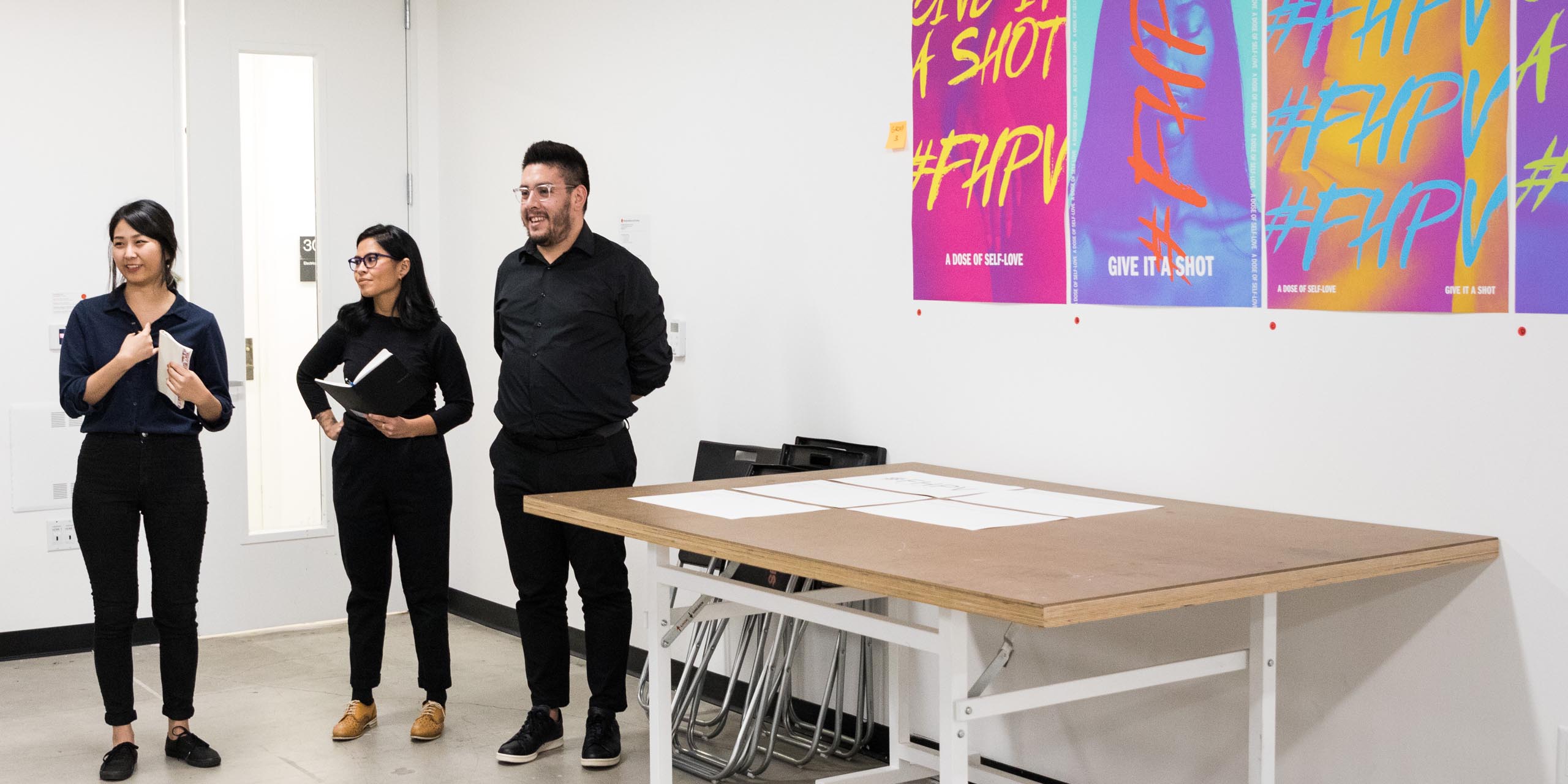
“Being given different opportunities to learn more about the LGBTQIA+ experience in Los Angeles was a very meaningful experience that I will keep with me and reflect on long after this studio ends.”
– Sarah Armakan, Student, Graphic Design
About Human Papillomavirus (HPV)
Human papillomavirus (HPV) is a group of more than 150 related viruses transmitted through intimate skin-to-skin contact. HPV is a fairly common virus to contract; currently, nearly 80 million Americans have one of the many types of HPV, according to the Centers for Disease Control and Prevention (CDC).
In 9 out of 10 cases, the immune system fights it off within a couple of years with no symptoms—though low-risk HPV strains can cause genital warts. High-risk HPV causes the majority of cancers of the cervix, vagina, vulva, penis, anus and throat. A vaccine can protect the types of HPV that most commonly cause cancer.
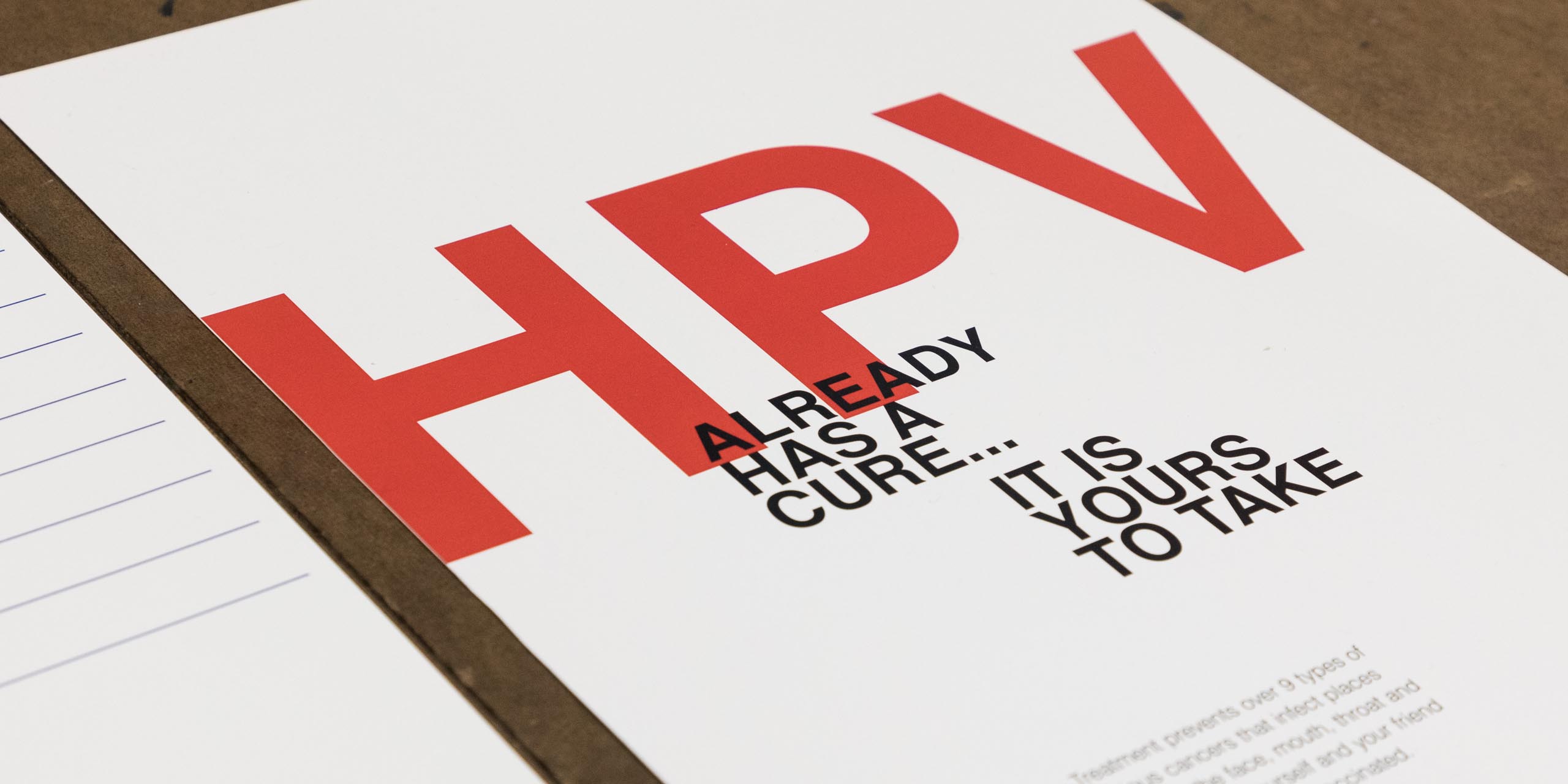
“This is just so impressive. Each one of the presentations had some unique quality that drew me in….there were lot of things that were woven through each one of the presentations, like the hashtag, which was really brilliant.”
– Dr. Marc Goodman, Cedars-Sinai Samuel Oschin Comprehensive Cancer Institute
Research and Project Development
Kicking off the studio, representatives from Cedars-Sinai and stakeholders traveled to ArtCenter to present research, background and project objectives. Cedars-Sinai has been studying in-depth certain cancers associated with HPV and the outsized impact on LGBTQIA+ communities.
Students were introduced to the various community stakeholders who play a part in Cedars-Sinai research and outreach; the Cedars-Sinai Community Advisory Board includes health practitioners, community organizations, ethnic and immigrant groups as well as LGBTQIA+ advocates.
Students discovered about the numerous barriers to healthcare faced by young members of the LGBTQIA+ community and gained an understanding of the implications of HPV and HPV-related cancers. They also learned how a series of three vaccinations can prevent a host of cancers related to HPV, but that communicating this information to youth has particular challenges. For example, communication about the HPV vaccine was primarily targeted at cisgendered teenaged girls and their parents due to the relationship between HPV and cervical cancer; however, as the research indicated that HPV also causes cancers in the throat, anus and penis, healthcare professionals began recommending everyone receive the vaccine.
Students, clients and stakeholders engaged in a robust question and answer session; representatives provided students with possible campaign tactics that could bridge the gaps between knowledge and access to care. The underlying message needed to convey a positive and friendly point of view.
Divided into teams, students delved into researching their target audience and began ideating possible branding elements for their campaigns. As a class, students took a field trip to the Los Angeles LGBT Center, which has cared for LGBT individuals and families since 1969. The Center offers health services, social services and housing, culture and education along with leadership and advocacy.
Students learned about the numerous health programs and services offered to the LGBT community – many involving HPV and cancers – while also discovering more about that demographics’ specific needs and concerns. By creating a safe space for LGBT community, the Center has unique perspective on how youth responds to messaging especially since there is general mistrust of organizations and a sense that they are invincible to diseases such as cancers.
Teams discussed ways they could graphically convey a familiar conversational tone – as if interacting with a friend – with color, tone, typography and text to support the message of self-love and how building community could end HPV.
Students knew the campaign needed to be interactive and engaging, however, they also realized they needed to push boundaries in order to reach their target demographic. Finding the balance was a unique challenge: what imagery/text crosses over into offensive? What is too much and too far?
Erik Adamian, Associate Director of Education for the ONE Archives Foundation, visited the class to lecture on LGBT+ history in Los Angeles, and guide the students through a walk-through of a mobile exhibition on the history of HIV/AIDS activism. Students saw the bold imagery and direct language used to affect change through the 80’s and 90’s, and decided to push their concepts further and ask the community stakeholders to guide them as to what is effective, engaging and exciting.
Teams continued to fold into their campaigns simple but eye-catching imagery, logo designs and branding verbiage that could quickly grab attention. Since the campaign would be employed in various communities, messaging also need to be fluid enough to transcend one specific group. Affordability and the ease of campaign implementation across multiple stakeholders also was a key consideration.
At the midterm presentation, teams shared their design elements to Cedars-Sinai representatives, stakeholders and experts. Each group received ample and productive criticism which gave students solid direction moving forward. Clients and stakeholders huddled together to form a unified consensus on necessary thematic imagery, messaging/taglines and important conceptual considerations.
Originally, the faculty assumed at this point in the studio students would have combined into one holistic team, however, it was decided that the opportunity for groups to creatively evolve their initial design concepts would provide a deeper and more meaningful studio experience while offering stakeholders a wide variety of assets to consider for implementation.
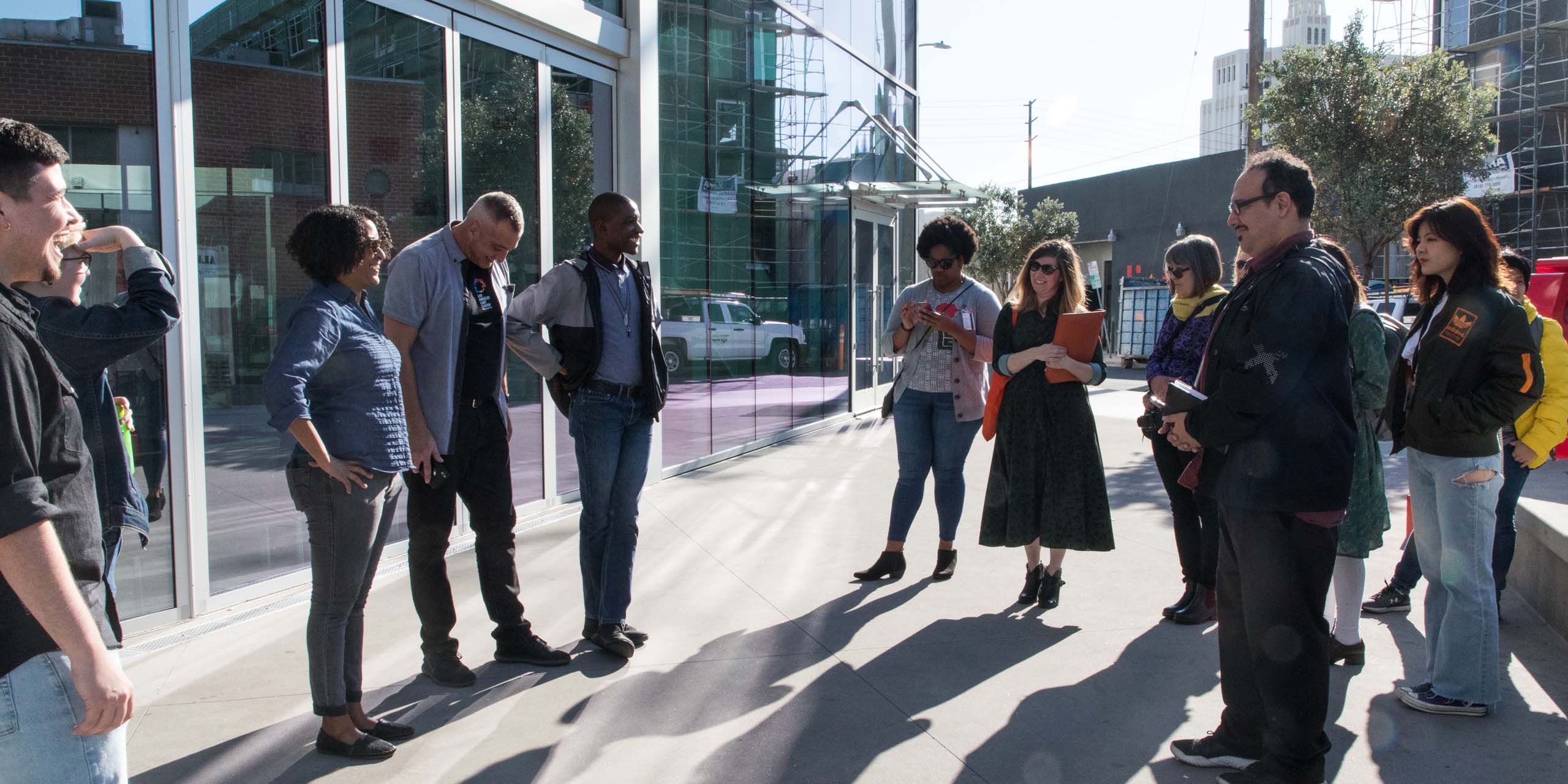
“I learned a lot during the design process and being involved in this studio. I know it is not easy to create something out of conversations, yet the students were able to do that effectively and beautifully; and that was a learning process for me as the students explained what they learned from presentations and conversations with the LGBTQ+ community partners and myself.”
– Charlie Ruiz Vazquez, Cedars Sinai
Studio Continues with COVID-19 Restrictions
Days after the midterm presentation, students and faculty resumed the studio virtually because of the COVID-19 closure of the ArtCenter campus.
Students met as a class and as teams online, sharing how they were incorporating the feedback into their campaigns. Zoom meetings often included spirited discussions about project nuances and directions.
Three teams adjusted their branding messaging to be: “Let’s Talk About Ending HPV” while one continued with their original tagline of “An Act of Self Love Can Prevent HPV.” All teams adopted the hashtag #FHPV which could represent “Fight HPV” or a slightly more provocative and edgier interpretation that would appeal to the youth audience.
As teams honed their campaign elements, they incorporated multilingual options for specific neighborhood and communities. The studio’s final presentation was given via Zoom to over 30 external guests where teams outlined their campaign’s specific print, digital and spatial elements, presented branding concepts for social media/sway giveaways and demonstrated effectively and affordable ways of execution.
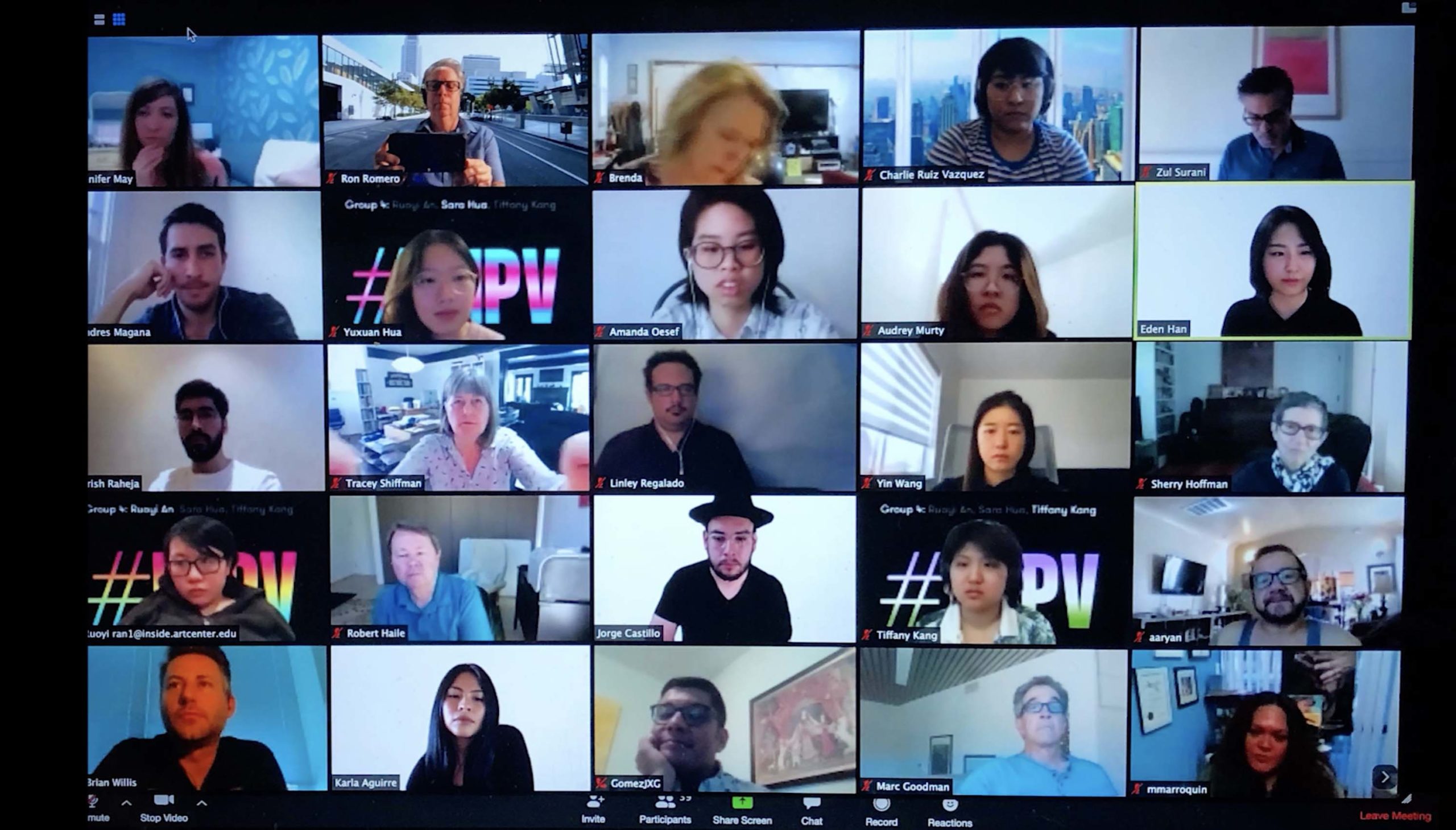
“I think these presentations are fantastic. The work is incredible. I’m really impressed how the students took the feedback to create really sharp and clean designs. I work in a place with two totally different dynamics: West Hollywood and South Los Angeles. Our target demographics are completely different. The environment is completely different. Our clinics are completely different, inside and out. The different elements you have presented speak very clearly to our different demographics. For example, I can see a mural on our building in South LA. I’m looking forward to being able to put all of this to action.”
– Brian Willis, Men’s Health Foundation
Project Outcomes
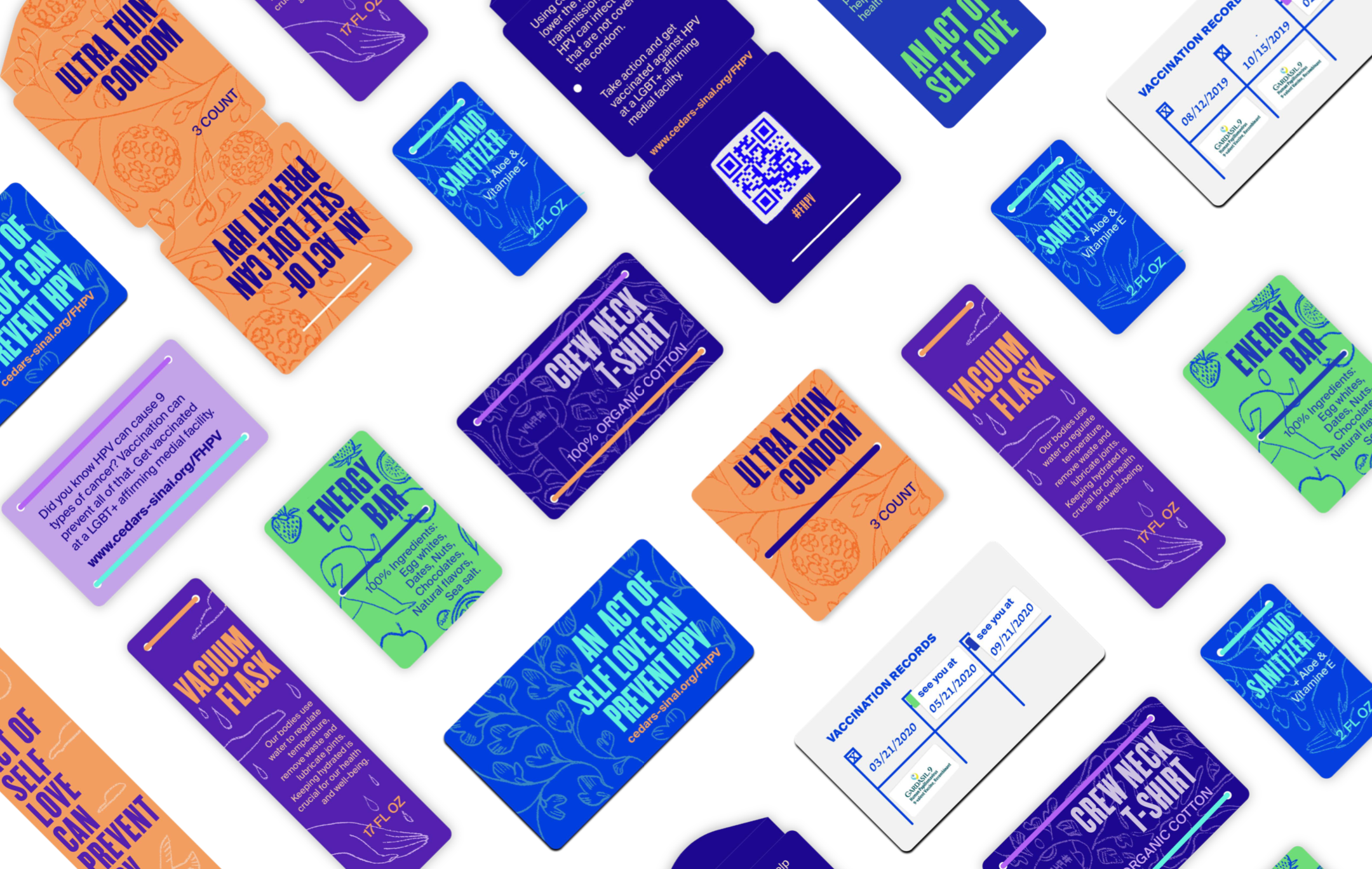 close
close
Team 1: “An Act of Self Love Can Prevent HPV”
Read moreSarah Armakan, Audrey Murty, Linley Regalado, Yin Wang
Positive imagery and friendly graphics invite target groups into dialogue and discussion. Typography appears casual but also conveys knowledge. The simple and direct tagline encourages community members to take action on behalf of their health.
Poster/banner and billboard explorations feature large genderless images with bold text. Color combinations are inspired by variations of rainbow symbolism. Posters can be placed side-by-side for maximum impact and can be installed in subways, street scenes and clinics.
Digital media designs includes an easy-to-access website that answers questions and provides links to services; and social media platforms that feature colorful imagery, hand-drawn “guerrilla-style” animation and interactive stories (bingo games, etc.) that can be shared on the theme of self-love and taking action.
Taking a cue from public gatherings such as Pride, art murals (for selfie photos) can incorporate the branded imagery along with the hashtag #FHPV. Representatives at public gatherings can engage participants to use a digital sign-up sheet to schedule a clinic visit. To help clients keep track of their series of three shots, clinics can hand out logo branded post-vaccination cards.
Various-shaped stickers with illustrated imagery can have multiple uses; when affixed on products (energy bars, condoms, plastic bottles, t-shirts, hand sanitizers, etc.) they are part of a larger promotional handout. Budget-friendly messaging tags can also be incorporated onto these giveaway items that also have spaces for stakeholders to display their logos.
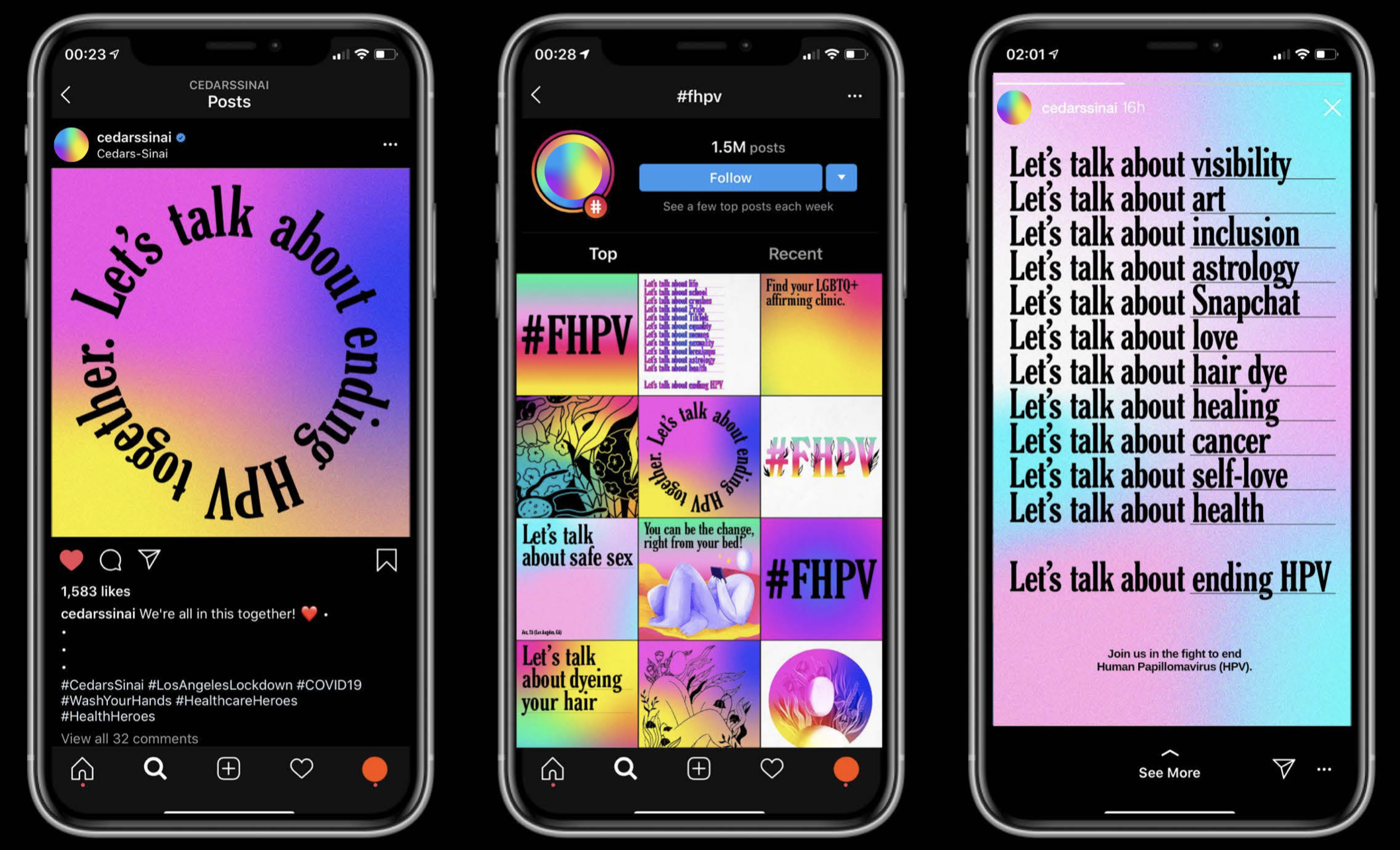 close
close
Team 2: “Let’s Talk About Ending HPV”
Read moreBlossom Liu, Amanda Oesef, Krish Raheja, Amanda Oesef
HPV is folded into the common topics of youth conversation as a friendly and familiar environment for the target audience. Posters, billboards and banners reflect popular everyday discussions interwoven with serious subjects. Colorful rainbow gradient patterns and a repeating phrase “Let’s Talk About” creates an eye-catching design that feels approachable and nonjudgmental. Another variation features a singular phrase positioned as a colorful circle. The list becomes truncated for billboards and street banners that effectively blend together rainbow colors.
The campaign’s illustrative graphic style employs brightly colored organic imagery undulating among a contrasting black background adorned with the hashtag #FHPV. Images can be used as murals (for Instagram shares), stenciled on sidewalks, and on other neighborhood locations.
The campaign relies on the effectiveness of the hashtag to draw interest and followers while avoiding the time-consuming task of managing social media accounts. A social media kit can be distributed to partners/stakeholders who can join the social conversation using familiar graphics and messaging while customizing for their specific audience. Digital stickers can be added to selfies while interactive stories can encourage reposting.
The website, the home base for resources and information, utilizes line drawings and a rainbow palette background. The campaign’s visual language is carried throughout the sections.
Outreach resources employ consistent graphics and messaging: business-sized cards that list local clinics, digital sign-up sheets to invite participants into a clinic, and email reminders and follow-ups.
Sharable items will be cost-effective; stakeholders can use swag as giveaways, clinic promotions or as part of a larger thank-you bags: temporary tattoos, stickers, solo cups, water bottles, buttons and phone pop sockets, condom packaging. White t-shirts can be distributed at events (such as Pride) allowing recipients to customize them with their own tie-dye creation. Campaign imagery can be incorporated onto a giant fan, a popular Pride object.
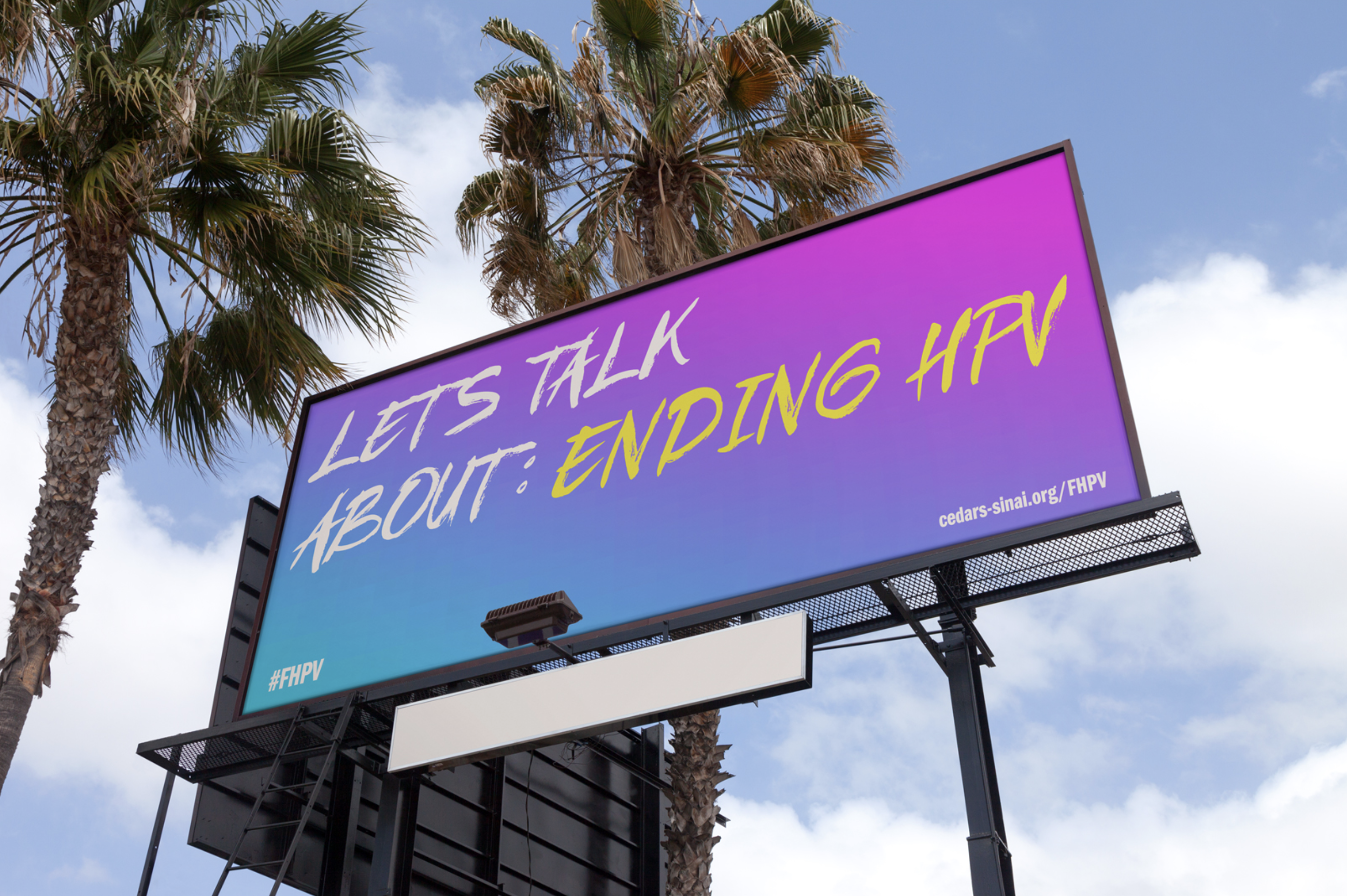 close
close
Team 3: “Let’s Talk About Ending HPV”
Read moreKarla Aguirre, Jorge Castillo-Rivas, Eden Han
Printed materials – posters, billboards, street banners – employ scratchy handwritten-script typography and up-close photographs of human lips presented in rainbow hues. Imagery suggests an intimate human conversation and connection. A series of these colorful posters can create a larger attention-grabbing graphic, especially when positioned in populated outdoor areas.
Shareable promotional items contain essential logo/type elements; swag products include pencils, bracelets, hats, stickers, lanyards and tote bags. Branded drink coasters with campaign imagery could be distributed at bars and restaurants. With a range of message designs, t-shirts can also be customizable at events with participants filling in the blank of “Let’s Talk About….”
Spatial design components bring the logo and message to streets and neighborhoods. The large handwritten hashtag could be placed on buildings, clinics and other structures. Chalk stencils on roads (especially during Pride parade) are easy to place and remove.
In a clinic setting, patients can access a QR App which launches a branded questionnaire with the promise of “Get cool stuff” by answering simple questions that will be kept private. The app design incorporates the branded color palette, text font and campaign sensibility.
Featuring the close-lip imagery and typography, the website presents a range of resources, information and clinic locations while encouraging clinic visits and vaccinations. The QR App questionnaire will be integrated here and visitors can learn their percentage of risk.
Social media will focus on the hashtag #FHPV as an interactive way to connect to audiences and engage them in spreading the message through posts, stories and sharing. Instagram filters will draw from campaign colors and the typographical tagline. Overall, the hashtag can provide an inexpensive repository of images that can be used by stakeholders in their specific arenas.
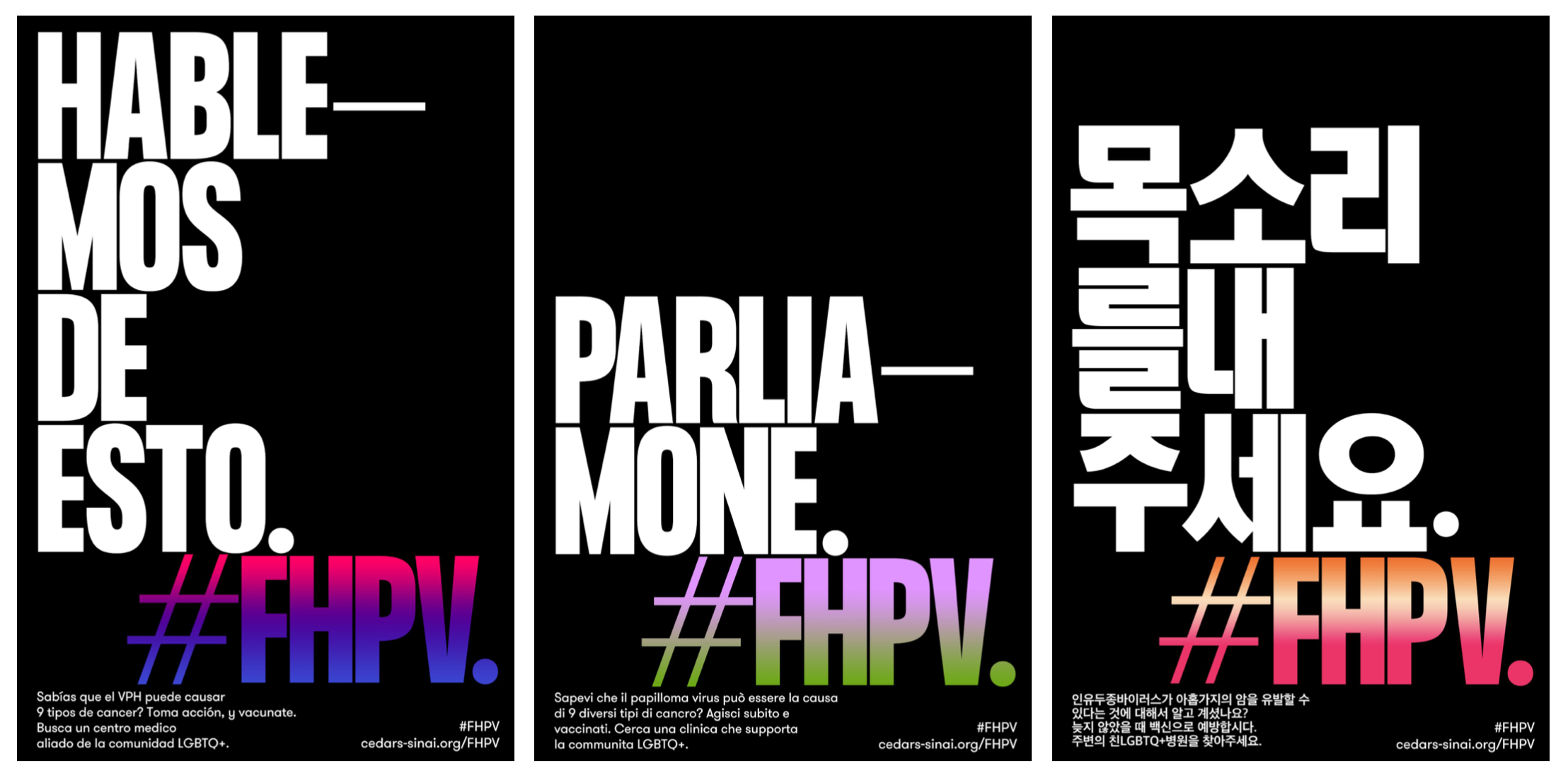 close
close
Team 4: “Let’s Talk About Ending HPV”
Read moreRuoyi An, Yuxuan Hua, Tiffany Kang
Contrasting graphics featuring white and rainbow text letters positioned over a black background set a powerful tone for this campaign’s print collateral. To appeal to different communities, colors combinations will vary. Street banners will implement different talking points to create curiosity and familiarity.
Rainbow decals with logo components can be affixed on sides of buildings as well as on staircases and outdoor steps.
The website landing page features the bold tagline with varying color gradients. Scrolling down, social media posts are featured prominently as well as YouTube testimonials, partner logos and contact information. The informational website is optimized for laptops and mobile applications.
Instagram and the hashtag #FHPV will be generously employed. The direct message imagery of “Let’s Talk About It” will be accompanied by a few HPV facts. To stand out, posts can incorporate simple animation with phrases that reveal the logo’s color combinations.
Branded logo stickers are used on promotional handouts. Stickers come in a variety of die-cut shapes – including chat bubbles – in order to match a variety of possible items such as water bottles, condoms, energy bars and hand sanitizers.
The list logo is on the front side of an emergency contact card, another care package item, and is a practical and inexpensive giveaway that can have lasting effect. Thick logo-branded tape can customize care packages and can also be used on other objects such as water bottles, notebooks, etc.

“The subject of the studio really made me learn what it was like to design not for designers, but for people. There’s also an amount of sensitivity and accountability with the things we create that was previously not on my radar, but are now things I will be considering when I design in the future.”
– Amanda Oesef, Student, Illustration + Designmatters Minor in Social Innovation
Next Steps
Cedars Sinai brought on student Blossom Liu from the studio as a Designmatters Fellow for Summer 2020 to continue to develop the campaigns from the class towards implementation. Pilot roll-out is planned for January 2021.